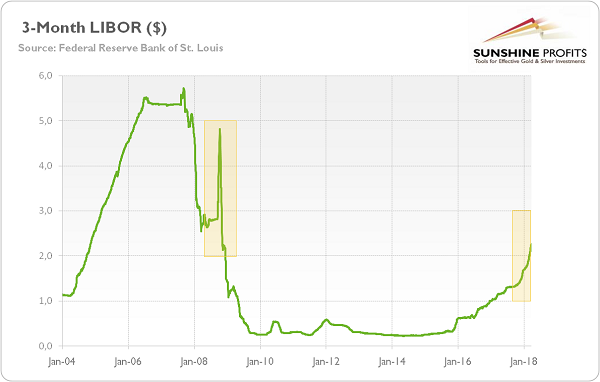Gold’s Old Friend Comes Back
Remember LIBOR? The interest rate which soared during the global financial crisis? It’s on the rise again, but almost no one is paying adequate attention to it. We are – and we will analyze for you what this means for the gold market.
Hello LIBOR, My Old Friend
Simon and Garfunkel sang about darkness, the old friend. We can refer these words to LIBOR which has come to talk with us again. I bet you remember the Great Recession well. But let me briefly remind you that LIBOR soared in 2008 as banks were reluctant to lend to each other. The stress in the financial system fueled fears, increased risk premia and made LIBOR rise. Gold shined then. Just see the chart below.
Chart 1: 3-Month LIBOR, based on U.S. dollar from 2004 to 2018.

Have you noticed the spike in the worst phase of the credit crisis? We marked that development by a yellow rectangle. But there is a second rectangle as well – much more disturbing, as it covers the present. Are we all doomed?
LIBOR Is Rising – Are We Doomed?
As the chart above shows, companies are paying the most in nearly a decade for borrowing indexed to LIBOR. Since 2016, the London Interbank Offered rate, which is the interest rate at which large global banks offer to lend funds to one another in the international interbank market, has risen from 0.61 to 2.27 currently. Does that increase signal the next financial crisis?
Well, not necessarily. As the Fed has been lifting the federal funds rate, the LIBOR had to rise as well.
However, the pace of increases in LIBOR has recently accelerated, outpacing the U.S. central bank actions. It shows serious signs of stress in the U.S. money markets. The spread between LIBOR and OIS, which is a popular indicator of distress in the banking sector, has jumped from 0.10 percent in November 2017 to almost 0.60 percent today.
Now, the key question is what the reasons behind that stress are. As in 2008, it might be a harbinger of another banking crisis, that’s for sure. But the recent surge in LIBOR seems to have been driven by technical factors. You see, Trump’s tax reform eliminated the incentive for U.S. companies to hold cash overseas. The repatriation of that cash led to lower demand for commercial paper, which in turn contributed to the rise in LIBOR. Not to mention the Fed’s unwinding of its balance sheet, new U.S. Treasury issuances, and the implementation of the Base Erosion Anti-Abuse Tax. Hence, the recent surge in LIBOR seems to be striking, but it doesn’t reflect the same panic mode as in 2008. Sorry, gold bulls.
Implications for Gold
We are watching LIBOR closely. In the Gold News Monitor from August 25, 2016, we addressed the issue of rising LIBOR (it hit a 7-year high then). We calmed investors that the increase was caused by new U.S. money market rules. Now, LIBOR is again on the rise. Actually, it climbed to the highest level since 2009, attracting some attention. However, the fears seem to be overblown, as the current rise seems to stem from technical factors, not from a banking panic.
Having said that, the rise in LIBOR may affect the gold market, even without the next financial crisis. Higher interest rates may put some downward pressure on the yellow metal, but they may also worry investors and spell trouble for overleveraged companies. Gold may benefit then as a safe-haven asset (with higher LIBOR, the Fed may also adopt a more dovish stance), but investors shouldn’t expect a replay of 2008-2009, at least not yet.
Arkadiusz Sieron



















